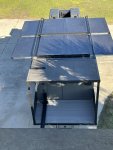Just saw this thread, lots of great ideas. I can share with you our 10 months on the road in eastern US, rarely staying more than one night at the same location and always prefer staying in the woods somewhere like national forests.
4ea 325 watt solar panels on top of the roof full time.
4 more under the top panels that are deployed using pneumatic cylinders/actuators. Press a button and the go out press another button and the go in.
Solar 2,600 watts of solar total when parked in an open area. Note only when you are confident that no one with a rig taller than your panels that they can do a close drive by and cause damage. That happened once we were fortunate our solar structure was stronger than the fiberglass fifth wheel.
Batteries 8ea 200 amph 12v total 1,600/19.2kwh
5,000 watt inver
12kw mini split 120v
All electric cooking with 2 burner induction cooktop, ninja all in one toaster oven.
12v Dometic full size rv fridge freezer
Diesel hydronic heater for water and habitat.
3,500 watt back up gas generator with 50 gallons of fuel for that alone.
We’ve never needed to connect to shore power during any season running AC and heat as needed.
Things I like, because you can’t always choose the direction to park in flat panels work in every direction as long as you can see the sky. Interesting fun fact on a cloudy day we start producing power earlier than a clear day. That whole light refraction thing.
The air space between the panels and the roof significantly reduced heat inside the habitat. And when deployed they make a great shade for the side of the vehicle and keeps the rain off the windows. Having hinged panels would possibly block your windows while inside and in situations where you can’t raise them.
My wife is a great cook and loves to do so. So all this is based on truly living out of it full time.
We can go approximately 3-4 days during the cloudiest rainy days and recharge the batteries with just the generator from 40 percent to 100 in about 4 hours using about a gallon of fuel.
Winter is a more challenging time with less sun at a lower angles and then if you are in a valley.





